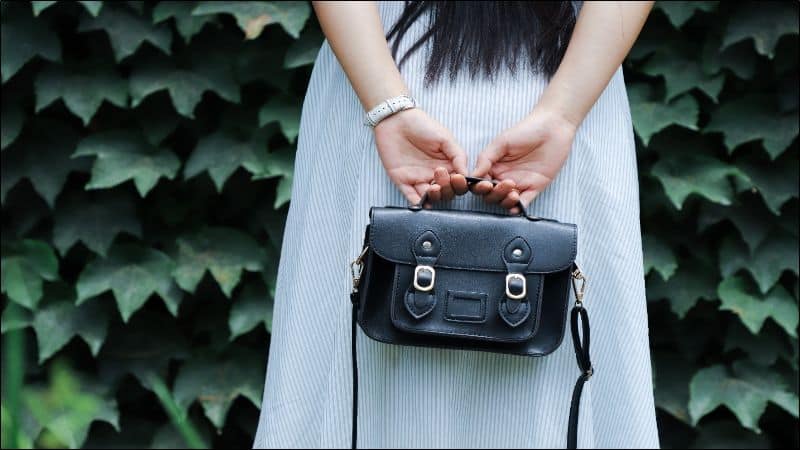Ever found yourself at the airport, juggling a purse, a carry-on, and the fear of extra fees? You’re not alone. The question of whether your handbag counts as hand luggage is as common as those pre-flight jitters.

Airlines have their own set of rules that can turn packing into a real puzzle. Let’s dive into the ins and outs of carry-on policies and find out where your trusty handbag fits in the overhead bin of air travel regulations.
Navigating the airport with confidence starts with knowing the luggage lowdown. So, does your ladies’ handbag need its own ticket to fly? Stick around as we unpack this travel conundrum.
What is considered hand luggage?
When you’re packing for a flight, knowing what counts as hand luggage is crucial. Hand luggage, also known as carry-on luggage, typically refers to the items you’re allowed to take with you into the plane’s cabin. The criteria for what qualifies as hand luggage depend on the airline you’re flying with, but there are some commonalities.
Firstly, hand luggage must fit within the dimensions and weight limits specified by the airline. These are non-negotiable and are strictly enforced at the gate. Most airlines provide size charts and boxes at check-in to make sure your bag fits the bill.
Here’s a quick breakdown of typical hand luggage limits:
| Airline | Dimensions (including handles and wheels) | Weight Limit |
|---|---|---|
| Airline A | 22″ x 14″ x 9″ | 15 lbs |
| Airline B | 18″ x 14″ x 8″ | 10 lbs |
| Airline C | 21″ x 13″ x 7″ | 20 lbs |
Remember, these numbers are just examples. Always check your airline’s specific guidelines before you pack.
Handbags often fall into a gray area. Some airlines treat a small purse or handbag as a personal item separate from your hand luggage allowance. However, if you’re carrying a larger tote or fashion piece that rivals the size of traditional carry-on luggage, it’s likely it will need to meet the hand luggage criteria.
Besides dimensions and weight, hand luggage must also adhere to security restrictions. Liquids over 3.4 ounces, sharp objects, and certain electronics must be checked or follow specific protocols. You’ll find many airlines promote their policies online, so there’s no excuse for arriving unprepared.
Knowing these specifications and checking your airline’s policy ahead of time ensures that you’ll breeze through check-in and security, leaving you more time for the finer things—like duty-free shopping or a peaceful wait at the departure lounge.
Airlines’ carry-on policies
When it comes to air travel, carry-on policies differ from one airline to another. It’s vital to check your ticket class and airline to avoid any hiccups at the gate. Typically, airlines allow you to bring a handbag in addition to your carry-on luggage without extra charges, but there are exceptions.
Most major airlines operate under a standard size limit for carry-on baggage. For instance, a common size you’ll encounter is 22 x 14 x 9 inches. Your handbag often won’t count against this limit if it fits under the seat in front of you. Think of your handbag as a personal item, separate from your carry-on suitcase. Yet, not all airlines are that generous.
Some budget airlines are stricter. They may enforce a one-item carry-on rule, where your handbag would need to be placed inside your single carry-on piece. This can be particularly challenging for those who like to keep personal items accessible. In such cases, choosing the right handbag—one that’s chic yet compact—becomes crucial.
Let’s break it down:
- Full-Service Airlines: You’re likely allowed both a carry-on and a handbag.
- Budget Carriers: Expect tighter restrictions, possibly limiting you to one item.
| Airline Type | Carry-On | Handbag |
|---|---|---|
| Full-Service | Yes | As personal item |
| Budget | Yes | Only if fits within carry-on limit |
Always check the baggage policy on your airline’s website before packing. Remember, oversized handbags could be a costly mistake. Fees for last-minute gate-checks can be steep.
Travel smart by choosing the right handbag. Opt for versatility and compliance with prevalent airline regulations. A tote that can stash a wallet, travel documents, and your in-flight essentials is typically a good bet. Keep in mind efficiency with style is key in maintaining a pleasant travel experience.
The role of a ladies’ handbag
A ladies’ handbag is more than an accessory—it’s your travel companion. Each handbag tells a story of personal style and necessity. You rely on this staple to carry your essentials: phone, wallet, and travel documents. It’s your on-the-go organizer, ensuring quick access to what matters most as you traverse through airports.
Let’s cut right to it: when flying, does your handbag count as hand luggage? The answer isn’t always clear-cut. Generally, a small handbag may not count towards your hand luggage allowance. Yet, this largely depends on the airline you choose. Standard policies allow for a handbag in addition to your carry-on, but beware—some budget carriers might not be as generous.
Here are key points to remember:
- Standard airlines usually permit a handbag along with your carry-on luggage.
- Budget airlines might restrict you to one piece, combining carry-on and handbag.
« Is It Bad Luck to Throw Away a Purse? Unveiling the Myths
Where to Buy Handbags in Paris: Discover Iconic Shops & Vintage Finds »
How do you master the art of traveling with a handbag? Be savvy when you pack, picking a handbag that’s versatile and within airline size restrictions. It should be compact yet spacious enough to hold necessities. Opt for designs with multiple compartments to distribute weight and stay organized.
Travel dynamics are changing, and so are hand luggage regulations. Changes can happen overnight. It’s vital to stay updated. Before heading to the airport, revisit the airline’s baggage policy. An overlooked detail about handbag allowances can disrupt your entire travel experience.
When choosing a handbag for air travel, practicality trumps fashion—but it doesn’t have to eliminate it. Aim for a balance; select a stylish piece that fulfills airline regulations. Remember, a well-chosen handbag alleviates stress, keeps you agile, and complements your journey from takeoff to landing and beyond.
Pros and cons of including a handbag in hand luggage
When deciding whether to include a handbag as part of your hand luggage, weigh up the benefits and drawbacks carefully. Don’t get caught off guard at the gate.
Pros:
- Access to Essentials: Your handbag keeps crucial items like your passport, money, and electronics within arm’s reach during your flight.
- Stylish Utility: Choosing the right handbag can add a dash of style to your travel outfit while serving a practical purpose.
- Space Optimization: A handbag allows you to maximize your carry-on capacity, ensuring you have everything you need on board.
Cons:
- Additional Security Checks: A separate handbag could mean more scrutiny at security, adding time to your travel.
- Size Compliance Risk: If your handbag doesn’t meet your airline’s policy, you may have to check it, incurring fees and the risk of loss.
- Physical Burden: Carrying multiple items through a crowded airport can become cumbersome, especially during long layovers or delays.
Remember, the key is to remain informed and adaptable. Always check your airline’s baggage policy before packing, and opt for a handbag that’s versatile enough to meet various airline requirements. Travel smart by selecting a piece that’s as efficient as it’s chic, ensuring it suits both your style and size restrictions. Keep an eye on evolving airline policies to maintain a hands-free experience as much as possible while still keeping your essentials on hand.
Tips for efficient packing
When you’re packing your handbag for a trip, think of it as curating contents for a mini journey. Every item should serve a purpose.
Start by listing essentials such as your wallet, travel documents, essential electronics, and a select few personal care items. This ensures you won’t forget anything crucial.
Opt for travel-sized products to save space. If you can’t find your favorite products in miniature, transfer them into small containers.
Organize your items with the use of compartments or packing cubes. Many handbags come with built-in organizers—use them to your advantage. If yours doesn’t, consider investing in a handbag organizer.
Choose a handbag that can easily slip under the seat in front of you or nestle into your overhead luggage. This makes it easier to access and store away during your flight.
To optimize space in your handbag, follow these steps:
- Roll or fold clothes tightly to prevent wrinkles and save space.
- Wrap cords and chargers neatly to prevent tangles and use elastic bands to keep them in order.
- Place heavier items at the bottom to distribute weight evenly.
- Slip smaller items like socks or chargers into shoes if you’re packing an extra pair.
Regarding tech items, remember that these often need to be removed for security screenings. Keep them in an easily accessible spot in your handbag.
Lastly, if you’re bringing a tablet or e-reader, consider downloading content before your trip to avoid using up your handbag’s precious space with unnecessary items like multiple books or magazines.
Adapting to your airline’s policies and the handbag’s capabilities is essential. Strategize your packing process for a seamless travel experience. Remember, an organized handbag is your key to a hassle-free journey.
Conclusion
So there you have it! You’re now equipped with the knowledge to make your handbag work for you as hand luggage. Remember, staying organized and packing smart will make your travel experience smoother. Keep your essentials within reach and your journey will be a breeze. Just don’t forget to double-check your airline’s specific policies before you head out. Happy travels and may your handbag be the perfect travel companion on your next adventure!
Frequently Asked Questions
What are the benefits of including a handbag in your carry-on luggage?
Including a handbag in your carry-on allows for better organization of essential items and provides easy access to things like travel documents, electronics, and snacks during your flight. This can enhance travel comfort and convenience.
What should you consider before adding a handbag to your carry-on?
Before adding a handbag to your carry-on, consider airline policies on luggage size and weight limits, as well as the need for quick access to travel essentials versus the extra weight and bulk it adds to your carry-on.
How can you pack efficiently with a handbag for air travel?
To pack efficiently, curate essential items, use travel-sized products, and use compartments or packing cubes. Choose a handbag that fits under the seat or in the overhead bin and optimize space by thoughtfully arranging items.
What items should get priority when packing a handbag for a flight?
Priority items for your handbag should include travel documents, electronics, chargers, essential medications, and personal items you’ll want easy access to, such as a book or headphones.
How can you optimize space in your handbag?
Optimize handbag space by rolling or folding clothes tightly, neatly wrapping cords, placing heavier items at the bottom, slipping small items into shoes, and ensuring tech items are easily accessible.
Is it important to download content before your trip?
Yes, downloading content such as movies, music, or books before your trip can save space for other items in your handbag, as you won’t need to carry extra storage devices or physical media.
How crucial is it to adapt to airline policies when packing a handbag?
Adapting to airline policies is crucial; it ensures that your handbag conforms to luggage restrictions, helping you avoid extra fees and inconvenience at the airport. It also contributes to a smoother travel experience.










